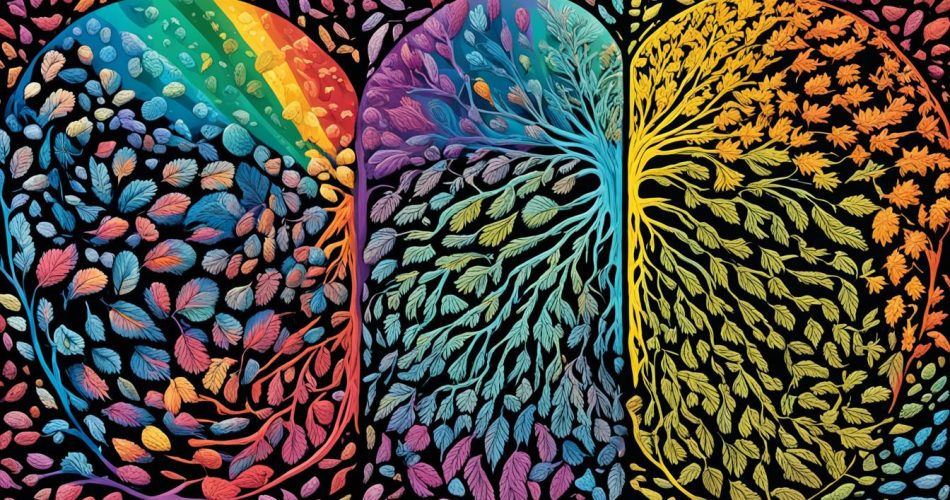Hi there, I’m glad you’re here! Today, I want to talk about a topic that is important for individuals with bipolar disorder – understanding the difference between hypomania and mania. These two terms may sound similar, but they have distinct characteristics that can affect a person’s mental and physical well-being. Let’s dive in and explore the symptoms and treatments associated with hypomania and mania.
Key Takeaways:
- Hypomania and mania are symptoms of bipolar disorder characterized by elevated mood and increased energy levels.
- The primary difference between hypomania and mania lies in the intensity and duration of the symptoms.
- Hypomania is a milder form of mania, lasting for a shorter period and typically not requiring hospitalization.
- Mania is more severe and can lead to significant functional impairment, often necessitating medical intervention.
- Treatment options for both hypomania and mania include a combination of psychotherapy and medications prescribed by a healthcare professional.
What is the Difference Between Mania and Hypomania?
Mania and hypomania share similar symptoms but differ in terms of intensity and duration. Understanding the distinctions between these two phenomena is crucial for accurate diagnosis and appropriate treatment. This section will explore the key differences that set mania and hypomania apart.
Intensity and Duration:
Mania is characterized by a higher intensity of symptoms and lasts for at least one week. It often leads to significant functional impairment, affecting the individual’s ability to perform daily activities. On the other hand, hypomania is milder in nature and typically lasts for a few days, although the specific duration may vary from person to person.
Common Symptoms:
Both mania and hypomania share common symptoms such as elevated mood, increased energy, and impulsive behavior. However, mania is often marked by extreme symptoms that can escalate to psychosis, including hallucinations and delusions. In contrast, experiencing psychosis during hypomania is rare.
Mania is like a whirlwind that sweeps me off my feet, while hypomania is more like a gentle breeze that adds some excitement to my everyday life.
To gain a clearer understanding of the differences, let’s take a look at a comparison table:
| Aspect | Mania | Hypomania |
|---|---|---|
| Intensity | High | Moderate |
| Duration | At least one week | A few days |
| Possible Psychosis | More common | Rare |
Remember, only a qualified healthcare professional can provide an accurate diagnosis and determine the most suitable treatment plan. If you suspect that you or someone you know may be experiencing symptoms of mania or hypomania, be sure to seek professional help for an evaluation.
Diagnosing Mania and Hypomania

Diagnosing mania and hypomania requires a comprehensive psychiatric evaluation. It is important for individuals to seek medical help if they suspect they are experiencing symptoms of mania or hypomania. The healthcare professional will conduct a thorough assessment, which includes:
- Reviewing the individual’s medical history to identify any underlying conditions or triggers.
- Performing a physical examination to rule out any physical causes of the symptoms.
- Evaluating the individual’s mood and symptoms, looking for specific indicators of mania and hypomania.
The duration of symptoms is an important factor in diagnosis. To be diagnosed with mania, symptoms must last for at least one week, while hypomania requires symptoms to persist for at least four consecutive days.
During the evaluation, the healthcare professional will assess the presence of symptoms such as:
- Markedly elevated mood or irritability
- Increased energy and activity levels
- Decreased need for sleep
- Racing thoughts and difficulty focusing
- Inflated self-esteem or grandiosity
- Increased talkativeness
- Engaging in risky behaviors
- Excessive involvement in pleasurable activities
If a diagnosis of mania or hypomania is made, the healthcare professional will work with the individual to develop an appropriate treatment plan.
| Signs and Symptoms | Mania | Hypomania |
|---|---|---|
| Markedly elevated mood or irritability | ✓ | ✓ |
| Increased energy and activity levels | ✓ | ✓ |
| Decreased need for sleep | ✓ | ✓ |
| Racing thoughts and difficulty focusing | ✓ | ✓ |
| Inflated self-esteem or grandiosity | ✓ | ✓ |
| Increased talkativeness | ✓ | ✓ |
| Engaging in risky behaviors | ✓ | ✓ |
| Excessive involvement in pleasurable activities | ✓ | ✓ |
Treating Mania and Hypomania
When it comes to managing mania and hypomania, a comprehensive treatment approach that combines psychotherapy and medication is often recommended. This dual strategy allows individuals to address both the underlying causes of their symptoms and the immediate mood-related challenges they may be facing.
Medications for Mania and Hypomania
Mood stabilizers: Mood stabilizers are commonly prescribed to help manage the symptoms of mania and hypomania. These medications work by stabilizing mood and preventing extreme mood shifts. Popular mood stabilizers include:
| Medication | Common Brand Names |
|---|---|
| Lithium | Eskalith, Lithobid |
| Valproic acid | Depakote |
| Lamotrigine | Lamictal |
Antipsychotics: Antipsychotic medications can also be used to treat mania and hypomania, particularly when symptoms are severe or accompanied by psychosis. These medications help regulate dopamine levels in the brain and can effectively manage symptoms of mania. Some commonly prescribed antipsychotics include:
| Medication | Common Brand Names |
|---|---|
| Olanzapine | Zyprexa |
| Risperidone | Risperdal |
| Quetiapine | Seroquel |
It’s important for individuals to take their medication as prescribed and communicate any side effects or concerns to their healthcare provider. This ensures that the treatment plan can be adjusted if necessary.
Psychotherapy for Mania and Hypomania
In addition to medication, psychotherapy can play a crucial role in managing mania and hypomania. Therapists trained in bipolar disorder can provide support, guidance, and education to individuals with bipolar disorder, helping them better understand their condition and develop effective coping strategies.
Cognitive-behavioral therapy (CBT): CBT is a widely used psychotherapy approach that helps individuals identify and change negative thought patterns and behaviors. By challenging irrational beliefs and learning healthy coping mechanisms, individuals with mania or hypomania can gain better control over their symptoms and mood.
Interpersonal and social rhythm therapy: This type of therapy focuses on managing daily routines and establishing stable social rhythms. By maintaining regular sleep patterns, exercise routines, and healthy relationships, individuals can minimize the risk of triggering a manic or hypomanic episode.
Psychotherapy can provide a safe space for individuals to explore their emotions, build resilience, and develop effective strategies for managing mania and hypomania.
Overall, the combination of medication and psychotherapy offers a comprehensive approach to treating mania and hypomania. By working closely with healthcare professionals and following the recommended treatment plan, individuals can find stability and regain control over their lives.
Coping with Mania and Hypomania

Living with mania and hypomania can be challenging, but there are strategies and support systems that can help individuals manage these symptoms effectively. Here are some coping strategies to consider:
- Learn about your condition: Educating yourself about mania and hypomania can give you a better understanding of what you are experiencing. It can also help you recognize your personal triggers and early warning signs. With this knowledge, you can take proactive steps to manage your symptoms.
- Keep a mood diary: Tracking your mood changes in a diary can be a valuable tool in managing mania and hypomania. By monitoring your mood on a regular basis, you can identify patterns and identify when you may be entering a manic or hypomanic episode. This can help you take appropriate measures to prevent the symptoms from escalating.
- Stay in treatment: It’s crucial to continue with your prescribed treatment plan, including medication and therapy. Consistency is key in managing mania and hypomania. Always take your medication as prescribed and attend therapy sessions regularly. If you have any concerns or experience side effects, communicate with your healthcare provider.
- Seek support: Building a strong support system is essential in coping with mania and hypomania. Reach out to loved ones, friends, and family who understand and can provide support during difficult times. Additionally, consider joining support groups specifically for individuals with bipolar disorder. Connecting with others who share similar experiences can reduce feelings of isolation and provide valuable advice and encouragement.
Quote from Bipolar Support Group Member:
“Finding support from others who truly understand what I’m going through has been a game-changer for me. It’s reassuring to know that I’m not alone and to learn coping strategies from people who have been managing this condition for years.” – Sarah, a member of a local bipolar support group.
By implementing these coping strategies and utilizing your support system, you can effectively manage the challenges that mania and hypomania present. Remember to prioritize self-care, maintain open communication with your healthcare provider, and reach out for help when needed.
| Strategies for Coping with Mania and Hypomania | Benefits |
|---|---|
| Learn about your condition | Gaining knowledge and understanding of mania and hypomania can empower you to effectively manage symptoms and recognize personal triggers. |
| Keep a mood diary | Tracking mood changes helps identify patterns and early warning signs, enabling proactive measures to prevent symptom escalation. |
| Stay in treatment | Adhering to prescribed medication and therapy regimens ensures consistent management of mania and hypomania. |
| Seek support | Connecting with loved ones and joining support groups provides understanding, encouragement, and valuable coping strategies from individuals who share similar experiences. |
Preventing Mania and Hypomania
While mania and hypomania cannot be completely prevented, individuals with bipolar disorder can take steps to minimize the risk and manage their condition effectively. By implementing strategies for preventing mania and hypomania, individuals can maintain stability in their mood and overall well-being.
Maintaining Support Systems
One of the key strategies for preventing mania and hypomania is to maintain a strong support system. This can include family members, friends, therapists, and support groups specifically for individuals with bipolar disorder. Having a support system in place allows for open communication, guidance, and assistance when needed.
Sticking to the Treatment Plan
Adhering to the treatment plan prescribed by a healthcare provider is essential in managing bipolar disorder and preventing episodes of mania and hypomania. This may include taking medications as prescribed, attending therapy sessions, and following any lifestyle recommendations given by the healthcare provider. Regular check-ins with the healthcare provider can help monitor progress and make any necessary adjustments to the treatment plan.
Seeking Help if Needed
If any signs or symptoms of mania or hypomania become apparent, it is crucial to seek help from a healthcare provider promptly. Early intervention can prevent these episodes from escalating and causing significant disruptions in daily life. The healthcare provider can provide guidance, explore treatment options, and make necessary adjustments to the current management plan.
Adopting Healthy Lifestyle Habits
Incorporating healthy lifestyle habits into daily routines can also contribute to preventing mania and hypomania. This includes maintaining a balanced diet, engaging in regular physical activity, and prioritizing sleep. A healthy lifestyle supports overall well-being and helps to regulate mood and energy levels.
By implementing these strategies and actively managing bipolar disorder, individuals can reduce the likelihood of experiencing episodes of mania or hypomania. It is essential to remember that everyone’s journey is unique, and finding what works best for each individual may involve some trial and error. With a proactive approach and ongoing support, managing bipolar disorder becomes more manageable, leading to a better quality of life.
Conclusion
In conclusion, mania and hypomania are symptoms that can manifest in individuals with bipolar disorder. Although they share similarities in symptoms, they differ in terms of their intensity and duration. Mania is a more severe form of mood disturbance that may require hospitalization, whereas hypomania is milder and generally does not necessitate hospitalization.
Diagnosing mania and hypomania requires a comprehensive psychiatric evaluation, considering factors such as the duration and intensity of symptoms. Treatment for both conditions typically involves a combination of psychotherapy and medication. Psychotherapy, such as cognitive-behavioral therapy, can provide individuals with support, guidance, and education to better manage their symptoms. Medications such as mood stabilizers and antipsychotics may be prescribed to help stabilize mood.
Coping with mania and hypomania involves self-care strategies and building a strong support system. By learning about personal triggers and maintaining a mood diary, individuals can be more aware of their mood changes and early warning signs. Sticking to the prescribed treatment plan, attending therapy sessions, and seeking support from loved ones and support groups can help manage symptoms effectively. Although mania and hypomania cannot be completely prevented, individuals can take steps such as maintaining a balanced lifestyle, including a nutritious diet, regular exercise, and prioritizing sleep, to reduce the risk of experiencing episodes.
FAQ
What is the difference between hypomania and mania?
Hypomania is a milder form of mania, with energy levels that are higher than usual but not as extreme as in mania. Mania, on the other hand, is a more severe form of mood disturbance characterized by atypically high levels of physical and mental energy that last for a week or more.
What are the symptoms of mania and hypomania?
Symptoms of mania and hypomania include higher-than-typical energy levels, restlessness, decreased need for sleep, increased self-esteem, talkativeness, racing thoughts, decreased inhibitions, and increased sexual desire.
How are mania and hypomania diagnosed?
Diagnosing mania and hypomania requires a thorough psychiatric evaluation. The duration of symptoms is an important factor, with mania requiring symptoms to last for at least one week and hypomania requiring symptoms to persist for at least four consecutive days.
What is the treatment for mania and hypomania?
Treatment for mania and hypomania often involves a combination of psychotherapy and medication. Medications such as mood stabilizers and antipsychotics may be prescribed to help manage symptoms, and psychotherapy, such as cognitive-behavioral therapy, can provide support and education.
How can I cope with mania and hypomania?
Coping with mania and hypomania involves self-care strategies and support systems. Keeping a mood diary, staying in treatment, and seeking support from loved ones and support groups can help manage symptoms and reduce feelings of isolation.
Can mania and hypomania be prevented?
While mania and hypomania cannot be completely prevented, individuals with bipolar disorder can take steps to minimize the risk and manage their condition effectively. This includes maintaining support systems, sticking to the treatment plan, and adopting healthy lifestyle habits.
What are the key points about mania and hypomania?
Mania and hypomania are symptoms that can occur in people with bipolar disorder. Mania is more severe, often requiring hospitalization, while hypomania is milder and typically does not require hospitalization. Diagnosis and treatment involve a thorough psychiatric evaluation, including medication and psychotherapy. Coping strategies and support systems can help manage symptoms, while healthy lifestyle habits can contribute to overall well-being. Preventing mania and hypomania involves minimizing risk factors and effectively managing the condition.

